Plant Description
The Tillandsia genus, widely known as air plants, consists of 650 species. Native to southern North America through to South America, air plants have evolved to inhabit ecological niches found within various forest, mountain, and desert environments.
For this reason, air plants make perfect indoor plants as they are highly adaptable and quite enjoy the conditions of a domesticated lifestyle.
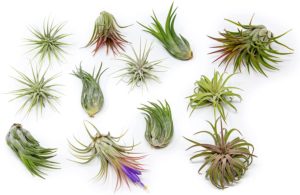
Air plants are generally low maintenance and can survive, and even thrive, without being planted into a soil mix or a traditional growing substrate. In fact, they much prefer it this way. Instead of soil, Tillandsia species are commonly attached or mounted to wood pieces, seashells, stones, or are even added to open glass terrariums.
This soil-free life makes air plants a type of epiphyte. An epiphytic lifestyle is made possible by aerial roots and tiny hair-like growth called trichomes. Aerial roots gather nutrients and moisture from the surrounding air rather than from a growing substrate.
Trichomes also play a similar role in that they help to collect water and moisture or airborne nutrients. Although, they also provide the plant with a slight layer of protection from direct sunlight – kinda like a layer of sunscreen.
Pretty cool, right?
Tillandsia air plant facts
| common name | Air Plant, Ball Moss |
| botanical name | Tillandsia spp. |
| no. of species | Approximately 650 |
| family | Bromeliaceae |
| biological life cycle | perennial |
| foliage | evergreen |
| mature size | 2-inches to 7-feet |
| time to maturity | 4-8 growing seasons |
| origin | native to forests, mountains, and deserts in the Caribbean, Mexico, Central America, South America, and the southern United States |
| light conditions | bright, indirect light |
| soil type | they’re air plants so no soil is required! |
| water pH | 6.5 is ideal but they will tolerate water pH levels varying from 4-8 |
| USDA Zone | 8-11 |
| toxicity | non-toxic to both humans and pets |
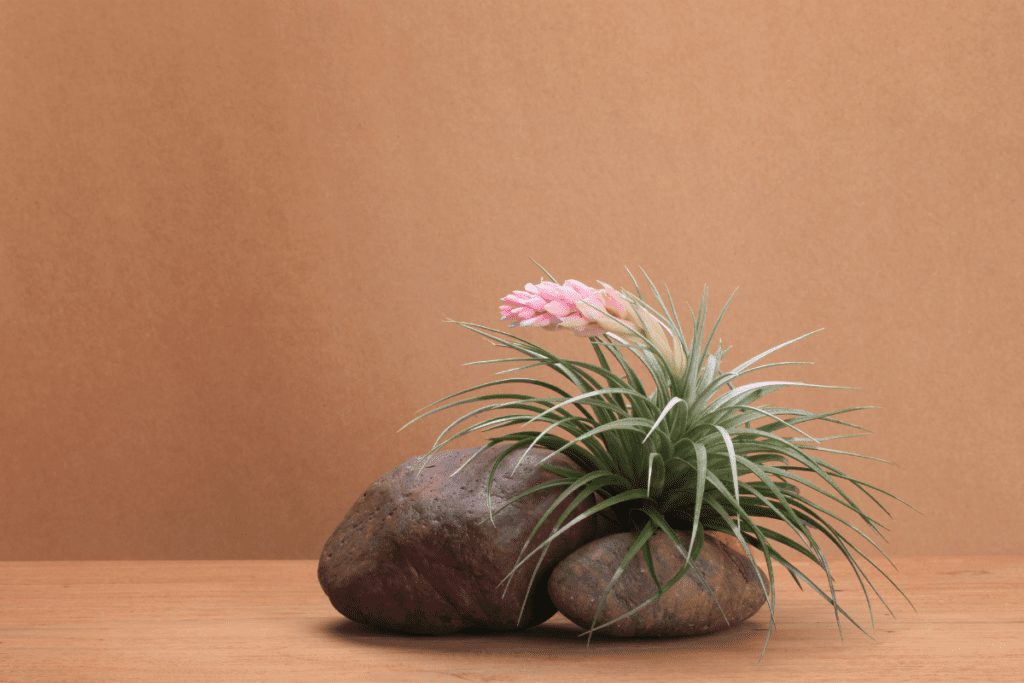
Popular Varieties
Tillandsia plants come in a wide array of different species, varieties, and cultivars that all make great houseplants. These include:
- Blushing Bride Air plant (Tillandsia ionantha)
- Upright Air plant (Tillandsia stricta)
- Xeric Air plant (Tillandsia xerographica)
- Spanish moss (Tillandsia usneiodes)
- Pink Quill (Tillandsia cyanea)
- Ballmoss (Tillandsia recurvata)
- Medusa’s Head (Tillandsia caput medusae)
How to take care of tillandsia
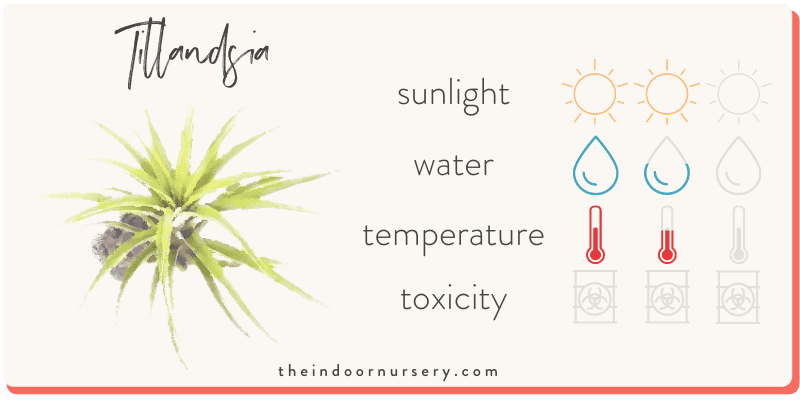
Tillandsia plants need environments with high humidity to grow. Misting between soakings is a great way to add humidity into the surrounding air and will ensure Tillandsia air plants will not dry out. Or if you live in a particularly dry region, adding a humidifier to the space can help keep your air plants sufficiently hydrated.
Air plant light requirements 🔆
Best light: bright, filtered light
Tillandsia plants should be placed in a location with bright, indirect, or filtered sunlight. As a general rule of thumb, variations with silver dusting and stiff leaves will generally require more sunlight than those with softer leaves.
Air plant water requirements 💧
Water requirements: once a week during the growing season (spring to fall) and less frequently during colder months. Or, if in the tropics, water more frequently during drier and less humid periods. A water pH level of 6.5 is best but anything between 4-8 is tolerated.
Despite not needing soil, Tillandsia plants have specific frequent watering requirements that will keep them healthy and happy. To water, soak the plant for 20-30 minutes or do a thorough rinsing at least once a week. Then, every 2-3 weeks do a longer rinse for a couple of hours.
After soaking, hang the plant upside down for at least 4 hours to ensure its root system completely dries off. This is super important, if there is any remaining water it can easily cause root rot and damage foliage. If the plant needs more water between rinsings, light misting can be used. Just be sure not to overdo it.
To ensure your watering schedule is on point, monitor an air plant’s leaves to determine what watering schedule is best to keep them sufficiently hydrated. For instance, leaves will look softer or lighter in color if the plant is in need of watering.
Leaves that look wrinkled or rolled can be a sign of dehydration and if your air plant is showing signs like this you should immediately give it a drink.
A plant with stiff, turgid leaves is sufficiently hydrated and watering can probably wait. As an added consideration, air plants that are kept in hot and dry environments will require more frequent watering and those kept in cooler or humid environments may prefer to be watered less frequently.
The type of water is also very important when it comes to watering an air plant. Rainwater is best as it will contain atmospherically collected macro and micronutrients that are essential to an air plant’s survival. Although, if you can’t get your hands on freshly collected rainwater, distilled or filtered water can be used in conjunction with a specialized air plant fertilizer (more on that below).
Worst case scenario, tap water can be used. Just be sure to set it on a counter for a few hours so that the chlorine can evaporate before using it for watering an air plant.
Air plant humidity requirements 🌫️
Humidity preferences: it’s best to keep your air plants at around a level of 65% relative humidity.
Air plant temperature range 🌡️
Preferred temperatures: An air plant should be kept at a temperature range of between 50°F (10°) and 90°F (32°).
The preferred temperature range for Tillandsias is 50-60 degrees Fahrenheit at night and 80-90 degrees in the daytime. If outside, air plants will tolerate temperatures in the low 20s for very brief periods of time but they will need some form of protection to protect their sensitive foliage from frostbite.
Air plant fertilizer requirements💩
Fertilizer preferences: air plants will quite enjoy a fertilizer that’s balanced at 17-8-22 (nitrogen-phosphorus-potassium ratio)
Fertilizing Tillandsia plant varieties are not necessary but can help with growth, blooming, and overall health. Try using a fertilizer specifically formulated for bromeliads, with feedings frequencies spaced out to once or twice a month.
Water-soluble fertilizers can also be used at ¼ strength. For best results, mist an air plant thoroughly using a spray bottle, rainwater, and a specialized fertilizer – closely following the fertilizer manufacturer’s instructions, of course.
Air plant soil requirements
Sure, air plants don’t need soil to grow but they will require a place to attach themselves to. In their natural habitat, air plants are their happiest nestled in the nook of a tree trunk or when perched high upon the side of a rocky shelf.
In your home, they are quite happy to be attached to items like shells, driftwood, or even in a dry area within your bathroom shower.
Repotting tillandsia air plants
Repotting an air plant is quite simple as it isn’t rooted in soil. They’ll simply need to be attached to a surface, whether that be with a dab of a specialized air plant fixing glue, using soft tie wire, or with the help of a few strategically placed rocks, shells, or pieces of wood.
Because they don’t need soil, tillandsia are well suited to hanging pots like this diy macrame creation just for air plants. Just be careful not to bend or snap any leaves and roots in the process as they can be very fragile.
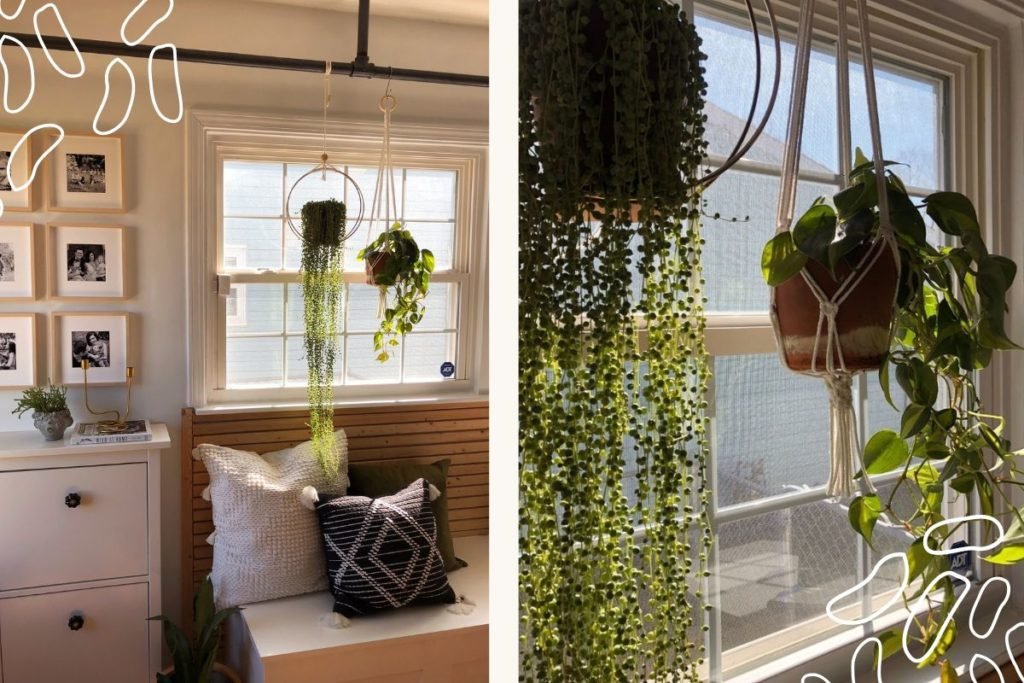
Propagating tillandsia air plants 🌱
During its reproduction process, Tillandsia plants create ‘pups’ that grow from the base of the mother plant. Wait until a pup is at least one-third the size of the full plant before propagating and starting a new plant.
To separate the pup, simply use a sharp knife and carefully cut it off – making sure not to create too big a wound. The new pup should then be grown and cared for as you would for any other air plant.
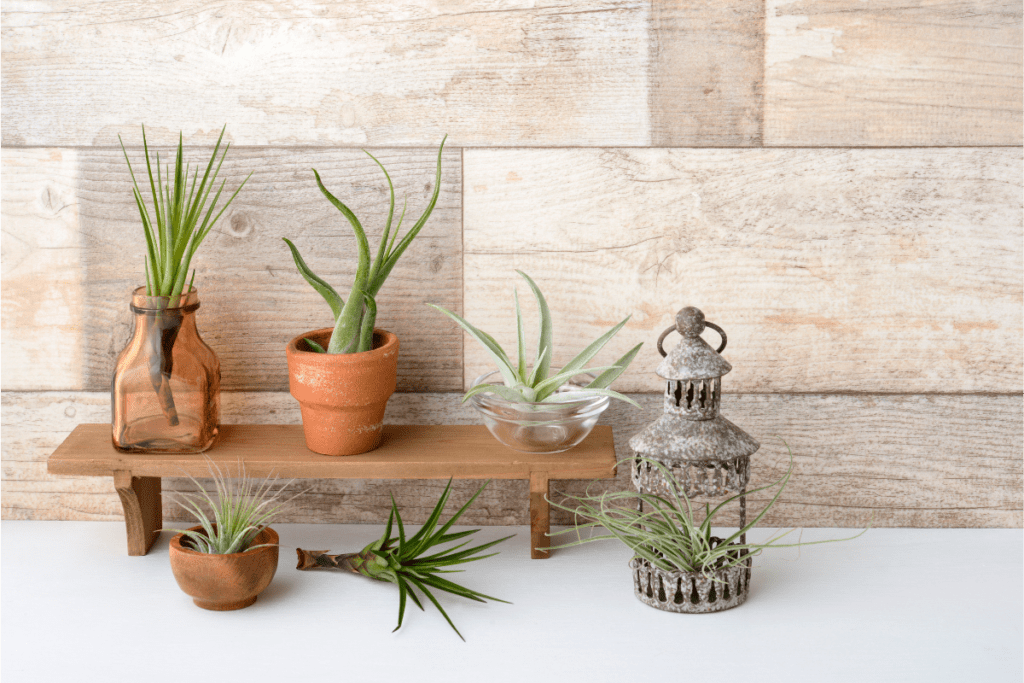
Pruning tillandsia air plants 🌿
If any leaves at the base of the plant have dried or wilted, they can be removed by gently pulling or cutting away with a sharp pair of thinly-ended scissors. Although keep in mind, if there are pups growing under a wilted leaf it’s best to keep them there for shelter and protection from the surrounding environment. Additionally, any leaf tips that are browned or dried can be trimmed at an angle for a natural look.
Pests and diseases 🐛
Pests: mealybugs and scale
Tillandsia plants can be prone to mealybug and scale pests. Mealybug will look like a waxy white cotton substance on the plant’s leaves. Scale insects will look like micro-sized shell-like bumps on stems or leaves. Both of these pests attack the plants in different ways, and will eventually cause them to become malnourished and eventually die.
The best approach to mitigating an air plant pest problem is to simply wash the invading insects off with running water. Although, if the pest problem is particularly bad, infected air plants should be separated from other indoor plants and sprayed with a suitable pesticide- something like a selective insecticide works best.
Tillandsia air plant care tips
- Open glass terrariums are a very popular display option for Tillandsia plants. Ensure that there is an open part of a terrarium for good air circulation and avoiding potential moisture build-up.
- Two common types of colors are green species and gray species. Green species enjoy cool-humid and shady climates. In native environments, they can be found on the lower levels of forests. They also fall under the Mesic category of plants, which means they originate from moderate-humid environments and prefer more frequent watering. Gray species thrive in areas with low precipitation and higher humidity. As they enjoy direct sunlight, their native environment is the upper floors of woods and on rocks. They also fall under the Xeric category of plants, which means they can function as normal (flower, seed, grow) in dry conditions. Many gray species are also epiphytic plants.
- Although an air plant and succulents have many similar features, they are not the same. The most notable difference between the two types of plants is that an air plant uses its aerial roots to absorb nutrients and moisture from the air whereas succulents receive these from the soil it’s planted in.
Common Problems / FAQs:
Why are my air plant leaves curled, browning, or soft to the touch?
The plant is underwatered and she is soaked and misted more frequently.
Why are my air plant leaves are soft or mushy, or can easily be pulled from the base?
This is a sign of rot. The most common cause of this is overwatering or water buildup. To avoid this, ensure the plant is thoroughly dried after each soaking by drying it upside down.
Why is my air plant’s coloring is fading?
Try placing the plant in a brighter location. Tillandsia plants should receive at least 4-6 hours of indirect bright light every day.
Shop our recommendations
- The Best Hydroponic Tower For Indoor Gardening
- 10 Best Worm Composter Bins For Easy Homemade Compost
- The Best pH Meter For Soil
- The 6 Best Dehumidifiers For Grow Tents
- The Best Complete Indoor Hydroponic Grow System
- 5 Best Grow Light Strips For Indoor Plants
- TESTED: Aerogarden vs Click and Grow Smart Garden
- Our *hands on* MARS HYDRO TSW 2000 review (with photos)
- 7 Best Hygrometers For Indoor Plants
- The Best Coco Coir For Your Plant’s Healthiest Root System Ever

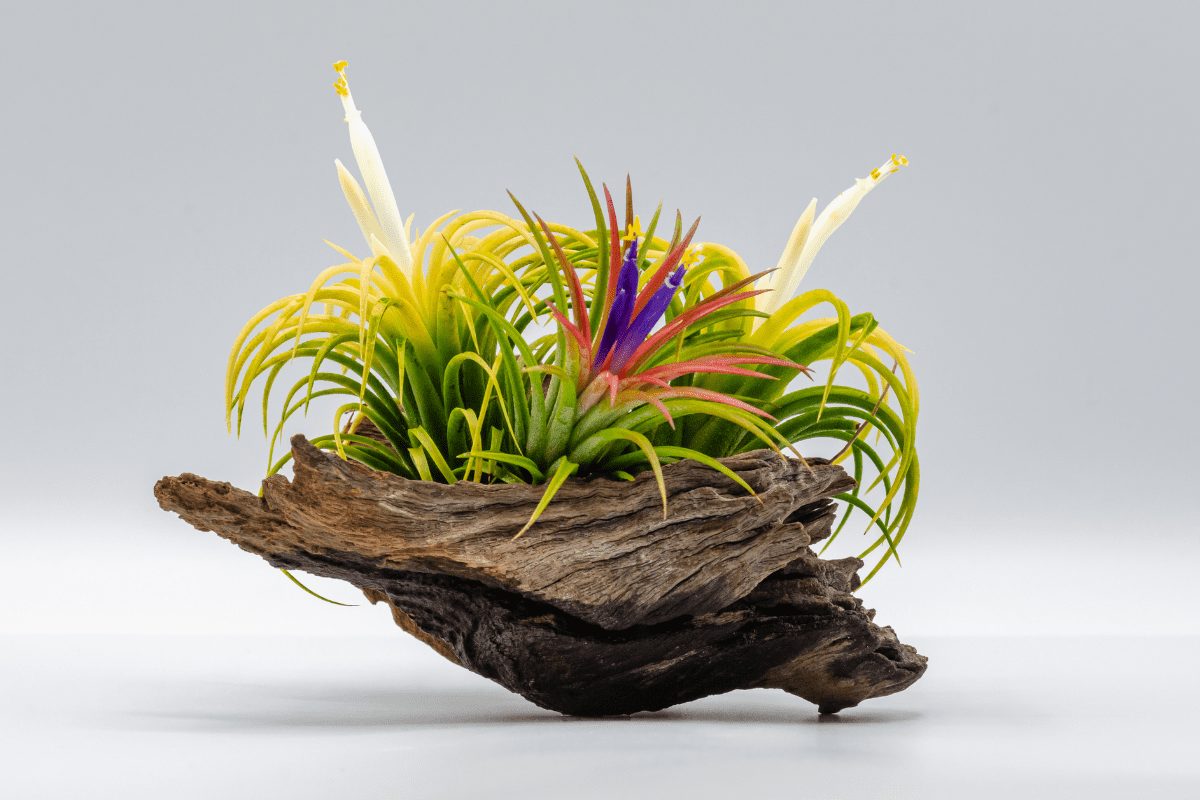
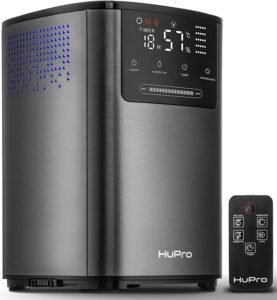
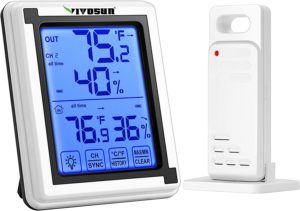
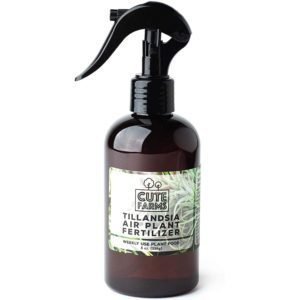



Hey, Marcia! Thanks for reading :) gosh, that's a great idea to double up on your watering globe and spike.…